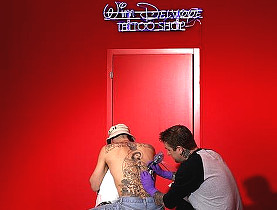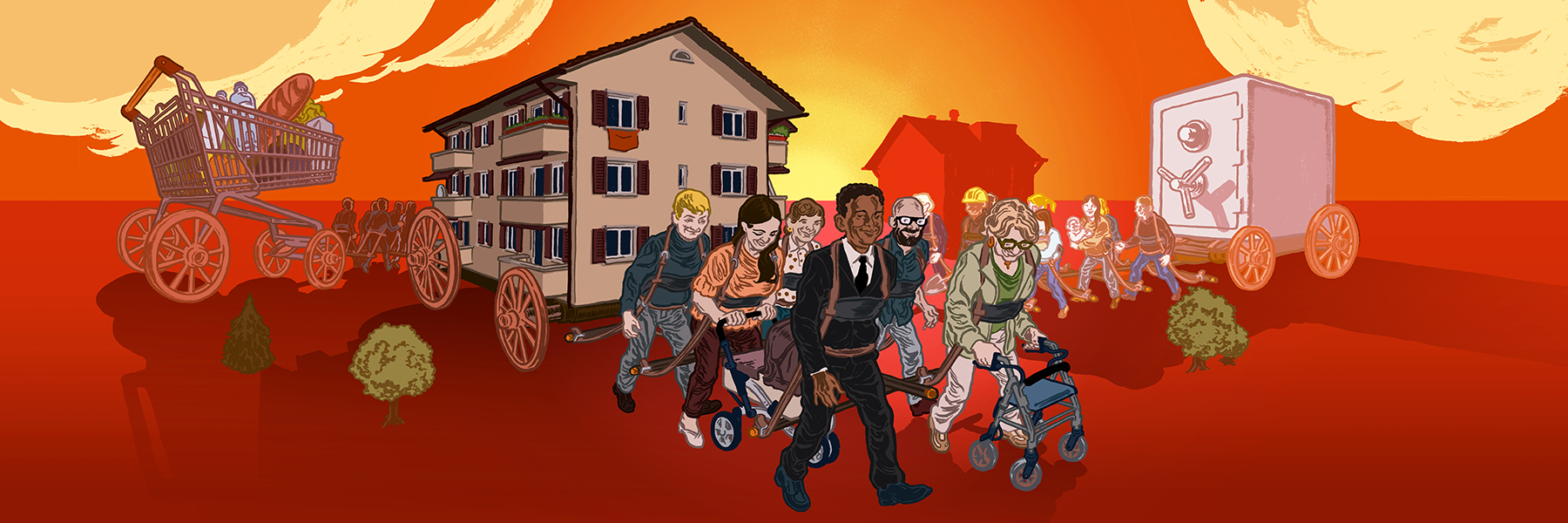
Swiss takes love of tattoos to the extreme

It was an art deal that would create strong bonds between all involved – the artist, his human canvas, the gallery and the buyer.
On a Friday in September, Tim Steiner signed over the life-long exploitation rights to a tattoo that adorned his back to a German art collector for €150,000 (SFr240,000). He also agreed to leave the skin to him when he died.
The deal was facilitated through the Zurich gallery de Pury & Luxembourg, which had been instrumental in pairing up Tim as a human canvas with Belgian artist Wim Delvoye’s tattoo project, and later the buyer Rik Reinking.
Steiner was already a fan of Delvoye’s work and when he heard about the chance to take part in his latest venture to create, sell and bequest a tattoo, he did not hesitate to come forward.
“I had been looking for an extreme experience and I realised that this was something I would like to take part in,” the 32-year-old Zurich musician told swissinfo. “And I was a big fan of tattoos.”
His family were doubtful at first, and asked whether he realised what it would entail. His father said he hoped his son would long outlive him and that he would not have to deal with the skin being removed.
His mother gave him her full support and said it was a “chance to experience something wild”.
Real art
The tattoo of the Madonna surrounded by Asian and African ritual symbols began as part of an art performance piece in 2006 and was completed in 2008.
Delvoye considers it to be the climax of his two previous bodies of work: tattooing symbols on to pigs, and the development of the Cloaca machine, an art installation that simulates the human digestive system.
“Like with every piece I make it tells more about other people’s minds than my mind,” he told swissinfo. “But this is one of these pieces where you don’t have to have seen it, it’s good enough to have heard of it.”
He adds that the “Tim” artwork has transcended his other pieces because it is “real”.
“It’s not so conceptual anymore. Also it’s giving away control. I cannot control Tim, the collector cannot control Tim, and there’s lots of elements we cannot control, it’s like a soup.”
Wim, Tim and Rik
An extra ingredient added to the pot was the relationship that developed between the two over the duration of the two-year project. The tattoo took around 35 painstaking hours to complete overall.
“We are like very good friends now. From the beginning Tim completely understood what I wanted to say,” Delvoye explained.
Another person who entered the dynamic was the buyer.
Hamburg collector Rik Reinking was an ideal candidate. The 32-year-old started collecting art at the age of 16 and now owns a number of performance and ephemeral artworks. But even so it took him several months to decide whether it was the piece for him.
“It is a difficult work of art. It pushes the boundaries of the acceptable not only in relation to art, but also on a moral level and in that sense is quite scary because it is unpredictable but simultaneously thought-provoking and ground-breaking,” explained Stephanie Schleiffer, of de Pury & Luxembourg.
“He wanted to be sure he truly understood what he was getting himself involved in.”
During the sale negotiations Steiner went to spend a weekend with Reinking to get to know one another and talk through all the eventualities.
“We have become friends,” said Steiner. “I feel comfortable and safe with him. Any issues I have I can share with him. The fact that he listens to my ideas could not be better for me.”
In the end Reinking bought the life-long exploitation rights to the tattoo. For his part Steiner has committed to leave the tattoo and skin canvas to the buyer in his will, but for legal reasons no money could exchange hands for this more controversial part of the deal.
The gallery and Steiner took a cut of the money but Delvoye waived his fee. In return Steiner is required to exhibit the work three times a year in public and private shows.
“We had to find a way for all the partners to sit together and to find a solution how this would work and how this was legally binding as far as possible. It’s very intricate,” said Schleiffer.
The unique nature of the artwork and the ensuing deal has created firm ties between Steiner, Schleiffer and Delvoye.
All three regrouped for the first exhibition of “Tim” at the ShContemporary Art Fair in September in Shanghai, where Steiner went on show at the Art Asia Pacific lounge in short sessions with his back set against a white backdrop.
Overwhelming
Steiner admits that life as he knows it has become “very intense”, with news of the sale spreading around the world and days later a whirlwind trip to Shanghai.
“It is all turning out bigger than I expected. I suddenly have a lot of friends. People who I have not seen for ten years are suddenly calling me up and saying let’s go out for a drink.
“Personally, I am really overwhelmed.”
Schleiffer added that the special nature of the project meant they all had to help each other.
“For the first time Wim has managed to find someone who committed his whole back and basically his whole life to him. Tim had to question everything about himself, about his beliefs, what he thought about art.
“It was and still is a very wonderful experience. But it is also tears on you. It’s quite something. It’s not just a painting. It’s a very fascinating and interesting journey.”
swissinfo, Jessica Dacey
Some tribal cultures traditionally created tattoos by cutting designs into the skin and rubbing the wound with ink, ashes or other agents. Others create tattooed marks by hand-tapping the ink into the skin using sharpened sticks or animal bones.
Currently, the most common method of tattooing is the electric tattoo machine that drives ink into the skin via needles attached to a bar, which is linked to an oscillating unit. The unit drives the needles in and out of the skin, up to 150 times a second.
Author Roald Dahl published a short story called Skin. It explains how a former tattoo parlor owner, Drioli, remembers the time he knew a now-famous artist named Soutine when he sees one of his paintings in an art gallery.
Thirty years before, Soutine had been in love with Drioli’s wife Josie, and Drioli asked Soutine to paint a picture on his back and then tattoo over it. Josie posed for it, and Drioli still has the tattoo on his back.
Drioli enters the art gallery, and shows the crowd his incredible tattoo. Two men give him a choice: one offers to pay for an operation on his back and the tattoo, while the other asks him to come to the Bristol Hotel in Cannes, and show off his back to the customers.
Drioli choses the second option, and leaves the gallery. Later, a “heavily varnished” painting of the same subject goes on sale in Buenos Aires. The implication is that Drioli was killed to obtain the art on his back although Dahl does not state this in his story.

In compliance with the JTI standards
More: SWI swissinfo.ch certified by the Journalism Trust Initiative



































You can find an overview of ongoing debates with our journalists here . Please join us!
If you want to start a conversation about a topic raised in this article or want to report factual errors, email us at english@swissinfo.ch.